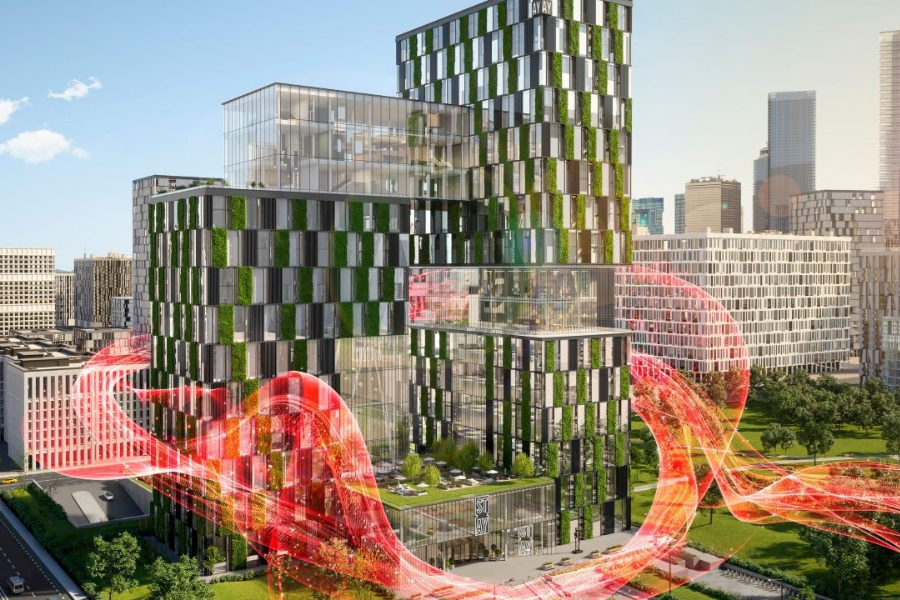Intelligent building solutions enhance health through innovative HVAC systems, air quality monitoring, and automated lighting. Integrating IoT and AI optimizes energy use and ensures a safe environment. These innovations promote well-being, improve indoor air quality, and support sustainable, efficient building operations, creating healthier living and working spaces.
Introduction to Smart Building Solutions
Due to the increased focus on sustainability and health, creating a healthy building environment is essential today. Healthy building systems offer a pathway to achieving safe, energy-efficient, and occupant-friendly spaces. Leveraging advanced technologies, these systems ensure a holistic approach to indoor environmental quality, making buildings not just structures but living, breathing entities that support human health and well-being.
Intelligent building solutions integrate various technological components to enhance occupants’ physical and mental well-being. This holistic approach seamlessly integrates heating, ventilation, air conditioning (HVAC) systems, lighting, and even security measures. Using IoT devices and big data analytics, these solutions help maintain the perfect interior climate, reduce energy consumption, and improve the general quality of life for the residents.
The Role of Technology in Healthy Buildings
Technology is the backbone of intelligent building solutions, integrating various HVAC, lighting, and security systems to improve indoor air quality and energy efficiency. IoT devices are pivotal, providing real-time data on air quality, temperature, and humidity levels. This information is then analyzed and used to make adjustments that ensure a comfortable and healthy environment for the building’s occupants.
Advanced analytics optimize these systems by continuously learning from the data collected. For instance, if sensors detect increased carbon dioxide levels, the HVAC system can adjust ventilation rates to bring in more fresh air. Similarly, intelligent lighting systems can dim or turn off lights if the building is unoccupied to save energy. These real-time adjustments make the environment healthier and significantly reduce energy usage and operational costs.
Critical Components of Smart Building Solutions
Several components work together to create an intelligent building environment. These include:
- IoT Sensors for Real-time Monitoring: These devices collect vital data on various parameters such as air quality, occupancy, and lighting conditions. The data collected provides crucial insights for maintaining a healthy and energy-efficient environment.
- Automated HVAC systems use real-time data to adjust temperature and ventilation, ensuring optimal indoor conditions. Advanced HVAC systems can also perform self-checks and alert maintenance teams when they detect anomalies, reducing the need for frequent manual inspections.
- Intelligent lighting controls: Automated lighting systems can adjust based on occupancy and natural light availability, reducing energy consumption and enhancing comfort. Daylight sensors, for example, may modify artificial lighting to match the quantity of natural light, saving energy and raising comfort levels.
- Data analytics platforms: These platforms analyze the data collected from various sensors to provide actionable insights for building management. By identifying patterns and trends, these platforms help make informed decisions, optimizing the building’s performance.
Benefits of Implementing Smart Solutions
Implementing innovative solutions comes with a multitude of benefits. For instance, research shows that intelligent buildings not only improve health and productivity but also lead to significant reductions in energy consumption. Here are some of the key benefits:
- Improved Indoor Air Quality (IAQ): By eliminating pollutants and guaranteeing a steady, clean air supply, sophisticated ventilation and filtration systems lower the risk of respiratory disorders and other health concerns.
- Energy Efficiency: Automated systems’ efficient utilization of resources dramatically lowers operating expenses and energy usage. This benefits the environment and results in substantial cost savings for building owners.
- Enhanced Comfort: Real-time temperature, lighting, and ventilation adjustments improve occupant comfort and well-being. This might decrease absenteeism and increase productivity, particularly in business facilities.
- Predictive Maintenance: Data analytics lowers maintenance costs and downtime by assisting in the early detection of possible issues before they develop into major ones. This proactive approach to maintenance ensures that all systems are running optimally, thereby extending the lifespan of building equipment.
Challenges in Adopting Smart Solutions
Despite the numerous benefits, adopting intelligent building solutions involves challenges. These include upfront implementation costs, data protection issues, and the requirement for highly qualified individuals to oversee and maintain these cutting-edge technologies. Comprehending and tackling these obstacles is essential to use intelligent building technology effectively.
- Initial Investment: The cost of installing intelligent systems can be high, which may deter some organizations from adopting these solutions. But it’s important to remember that the long-term savings and advantages frequently surpass the early expenses.
- Data Privacy: Data security and privacy concerns are growing with the increase in data collection. Ensuring that data is securely stored and used responsibly is crucial to gaining the trust of occupants and stakeholders.
- Technical Expertise: Managing and maintaining innovative systems requires specialized skills and expertise. Continuous training and development of professionals in this field are necessary to ensure the efficient operation of these advanced systems.
Future Trends in Smart Building Solutions
The future of intelligent building solutions looks promising with AI, machine learning, and blockchain technology advancements. These developments will significantly expand the potential of smart systems, improving their effectiveness, security, and usability. Some future trends to watch include:
- AI and Machine Learning: These technologies will enable more precise and predictive building management. By learning from data, AI-powered systems can anticipate needs and proactively adjust, further optimizing building performance.
- Blockchain Technology can be used for secure data sharing and management, ensuring data integrity and privacy. It can also facilitate transparent and efficient transactions, such as energy trading between buildings.
- Enhanced Human-Centric Designs: Future smart buildings will focus more on the well-being and comfort of occupants, incorporating features like customizable environments and wellness-focused amenities. This shift towards human-centric designs will make buildings more livable and enjoyable for their occupants.
Conclusion:
Transitioning to innovative building solutions is not just a trend but a necessity for creating healthier and more sustainable living spaces. While the journey may have challenges, the benefits outweigh the drawbacks. With continuous technological advancements, the future of healthy building environments looks brighter than ever. Accepting these advancements will open the door for structures that save resources and enhance the well-being of their residents, resulting in a more contented and sustainable community.
Keep an eye for more news & updates on Verifiedzine.com



